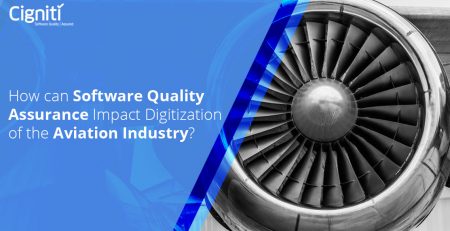Continuous Quality Assurance for multi-cloud strategy and management success
|
Listen on the go!
|
The most disruptive phenomenon in recent times is touted to be the evolution of digital technologies. In the process of driving digital transformation, organizations across the world are moving from legacy on-premise environments (technologies, processes, and platforms) to modern and sophisticated IT stacks.
One of the key steps in IT stack modernization is cloud adoption, which includes leveraging Infrastructure as a Service (IaaS), Platform as a Service (PaaS), and Software as a Service (SaaS) approaches through public, private, and hybrid adoption models.
According to a recent Gartner survey, “Public cloud users found that 81% of the respondents are working with two or more providers. In addition, the amount of business applications is set to double over the next couple of years.”
The multi-cloud strategy and management success hinges on two important factors –
- Developing a well-defined multi-cloud strategy and management including various phases and approaches and
- Ensuring continuous quality assurance of the program.
Building out a successful multi-cloud strategy
Adopting a multi-cloud strategy offers a whole lot of benefits and can allow you to mitigate risks and optimize costs when implemented correctly.
With access to multiple clouds, organizations can leverage the strengths of each provider and can combine them to get the “best of all worlds”, eliminating vendor lock-in and increasing agility.
As put forth by Michael Warrilow, Gartner Analyst,” most organizations adopt a multi-cloud strategy out of a desire to avoid vendor lock-in or to take advantage of best-of-breed solutions.”
While adopting a multi-cloud strategy has its own advantages such as resiliency, flexibility, and better return of investment (ROI), it is equally imperative to choose the right cloud provider.
A robust multi-cloud strategy and management success begins with an initial assessment of the IT application stack. Several factors such as the objectives of cloud migration and their alignment with business goals are taken into consideration.
It is also imperative to evaluate the risks while moving to cloud with respect to the integrations and data security. The type of cloud services to be adopted for identified applications such as IaaS, PaaS, and SaaS need to be considered along with the deployment models such as public, private, hybrid, and multi-cloud.
Cloud Testing Methodology
The cloud testing methodology comprises of the below steps:
- Understand and Assess – Identify the application, data, and services to be moved/hosted in the cloud. Also, identify their interactions with legacy systems and the technology dependencies of the cloud platform.
- Strategize and Plan – Determine the types of testing that are applicable based on the requirements and define the test parameters for each system component. Create test cases and test scripts for the identified scenarios and define the sandbox test environment.
- Maintain and Optimize – Maintain/enhance the test cases and test scripts for any application changes to ensure complete test coverage. Also, ensure continuous monitoring of the application and infra to ensure application availability.
- Test & Report – After actual hosting/migration, perform testing for all the key focus areas like functional, load, security, interoperability. Ensure that application is monitored and measured as per the service-level agreement (SLA). Report defects and collaborate with the Dev team for defect fixes.
Irrespective of the approach adopted for multi-cloud strategy, there is a need to apply continuous quality assurance techniques for better results and deliver value to customers. The benefits of Continuous Quality Assurance techniques include application performance, customer experience, scalability, and security.
Continuous Quality Assurance techniques for multi-cloud strategy and migration
Some of the key Continuous Quality Assurance techniques for multi-cloud strategy and migration include –
- Aligning with business: After all the applications are deployed to cloud, it becomes imperative to align with the business context. Key metrics such as ‘baselines values’ in the on-premise environment vs ‘observed values’ in the migrated cloud environment are covered through continuance quality assurance using automated test executions and monitoring during cloud migration.
- Security Assurance: The Cloud application security test types include injection, cross-site scripting, broken authentication & session management, insecure direct object reference, cross-site request forgery, security misconfiguration, insecure cryptographic usage, failure to restrict URL access, insufficient transport layer protection, and unvalidated redirects and forwards.
- Performance Assurance: The performance assurance is pivotal in cloud adoption. The focal areas of performance assurance include scalability, volume, availability, reliability, load & stress testing for single tenant, and capacity testing.
- Test automation: Test automation delivers security testing and automated integration at every critical point in the multi-cloud strategy.
- Customer experience assurance: Customer experience assurance is vital for many organizations and continuous quality assurance for all customer facing applications should include usability, mobile testing, cross browser and device testing, and high availability.
Achieving fast and continuous development & deployment of business-critical cloud-based applications across diverse platforms requires seamless collaboration among development, test automation, & operations teams.
Implementing continuous quality assurance for multi-cloud strategy helps CxO’s bring about a cultural shift that leads to greater collaboration across teams, improves the quality of code, increases the response rate of business changes, inculcates shift-left practices, & creates an environment of growth for Software Development Engineers in Test (SDETs) – all of which are necessary to provide continuous quality assurance solutions.
Cigniti’s experience in continuous quality assurance helped organizations increase their operational efficiency by 95%, improved mobile app usability by 45%, & reduced human intervention by over 30%.
Need help?
Talk to our continuous quality assurance experts. They will help provide a solution to your business and will demonstrate how to implement continuous quality assurance for multi-cloud strategy and management success.





Leave a Reply